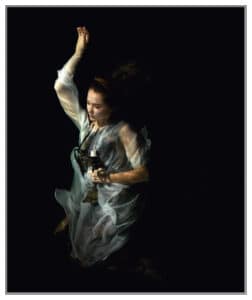
When did you start to make art?
I started shooting to hang for my own wall space aged only 15, and began making a living from it aged 21.
How did you evolve into a professional artist?
I knew what I wanted to do so I just kept shooting until I developed a strong enough understanding of the language of film to be able to earn a living – it took years I would like to add, only now am I able to say what I want through my own voice in the medium.
What drove you to make art as a professional vocation?
Working as an artist in any medium is a lifestyle choice as much as a professional one. Only if you are truly prepared to commit yourself can we tap into our inner creative resources at will, can we begin to live a creative life on our own terms.
Every moment of my life is constantly interpreted with my eyes as a photographer whether there is a camera in my hand or not – I have no choice in the matter now.
Talk to us a bit more about your ‘Taxi’ series. How did the concept begin?
This series illustrates my fascination with the energy of urban taxi’s at night: they glow with a sense or urgency in the business of someone’s journey playing out. The way the landscape of the city can interact with the reflective surfaces of the taxi is often overlooked – I want to capture that light play with the energy and bustle of city life and the stillness of individual with it.
How do you decide which country is suitable for the ‘Taxi’ series?
I have shot the series in Hong Kong, Shanghai, Singapore – but Tokyo is like the holy grail of taxi signage locations. I have spent many an hour happily walking it’s back streets looking for the shots.
In what way does your inspiration transform into ideas?
One of my biggest sources of inspiration is to simply stop what I am doing, take a deep breath and look around. It is amazing what you can find as a complete surprise even in the most familiar of spaces. I am always trying to spend my time interpreting what most people simply walk right on by without ever noticing. Much of my work is un-choreographed and I rarely take more than one shot of each subject, which on transparency film can be quite scary – but i find it is the best way to get an immediate response to a scene – then quietly moving on to the next.
From Ideas to production of art – how? And why?
Once I get the ideas for a shoot in my head they immediately start to develop – the next thing I know we are organising production meetings to realising them as full blown shoots before you know it.
Could your ideas be portrayed in any other medium? If so which?
Not for me – there is something mystical about the moment when light crosses through a lens, things are different from one side to the other, I am captivated with new ways of exploring this.
Why is your art made?
I’d make a terrible marriage councillor.
What does being an artists mean to you?
It negates the need for a nine to five job – I prefer 10am to 3am shift rota’s. No but seriously I think I have a great responsibility. We are the only creature on this earth that leaves signs of their creativity behind long after we are gone, I intend to make great use of this with the time I have left. Mortality is becoming an ever present influence on my work.
What would your response be to someone who claimed that photography was not a form of art?
I’d ask him when was the last time he saw a sunset – must be hard with his head jammed up his arse.
If you asked ten photographers or painters even dancers to spend an hour in a bare white painted room and interpret it the way they want – each will have wildly different responses. Surely this interpretation is what makes art the medium is irrelevant, but to make it good art today what you need is a profound technical knowledge. Good art has to unlock the valves of emotion and feeling, by this attempt to record the fact.
Are you happy with your reasons for making art? i.e Are there any trade offs that make life hard?
Absolutely, I absolutely believe in my practice although I am a workaholic which wreaks havoc in my personal life. I seem to suffer greatly for my art as I suffer for my loves, I have learnt to recognise though that a sense of humour is a means of survival for me.
You have worked with several different subjects in your career, which have you found the most enjoyable and challenging to work with? And why so?
I think being adaptable to many subjects is an important part of avoiding repetition, one of the most demanding aspects for me is the constant need to create fresh material from a diverse subject range. Music artists have it so easy – create one hit and they can base the next forty years of their career just repeating it over and over – a photographer has to create a new hit every time they pick a camera up. I am not complaining just very aware.
When does your art become successful?
When beans are off the menu.
How do you start the process of making work?
Somehow through my daily interactions I will get a seed in my head and over a period of time which can be from hours to years the seed develops until I start sketching it out and storyboarding the idea. Then we shoot it, the quicker the better as once the sketches are down it will drive me crazy until I get to shoot it – in fact having one un-shot idea can prevent a new seed from forming so I put a lot of pressure on myself to get things moving as quickly as possible.
Who prices your work? And how is the price decided upon?
I sell my work direct through the website and through arts dealers and collectives such as ArtMosh and KitchEN Gallery – they have helped position my works price wise. I only ever produce two editions of 10 hand finished prints which keeps things interesting.
What is your next; move,project,show etc?
So much is happening right now, we are being featured in the L.A Times Magazine in a months time. I am also working on a new dance series which is pretty exiting as we are shooting with the Banache dance company – one of the worlds premier companies.
We are also working on a body study series with a fetish twist along with planning a major solo show in London later this year featuring my series of Parkour which is always developing. We are in talks with some major brands sponsoring the show, nothing set in stone at this stage however, it’s a fairly new situation for me to have possible corporate sponsorship but I guess its part of entering the next stage of my career.
Which pieces would you like to be remembered for?
It’s too early for that, the best is yet to come of that I am sure…
What has been the biggest break in your career?
I don’t think I have had mine yet, I have had to push so hard at every turn and no one single event has had any major effect on my practice whatsoever – but I hope there is one on the horizon I’m due one, perhaps a FAD reader ….…
Who has been the biggest influence on you?
I think influences are dangerous – artists sometimes use this as some sort of brand association. I would much rather be an influencer myself, what do you think ??
I find the creative process fascinating and I am much more influenced if anything by the thought and approach to creation. Recently I was totally obsessed by a really obscene image in the Jeff Koons show at the Tate Modern. I kept coming back to it, without really knowing why but my thoughts were filled with ambiguity over why he does what he does, I guess I am still trying to understand my own work and find solace in understanding other peoples practice.
How many artworks have you given away and to whom?
I always give works away, to everyone involved in the projects in helping bring these images to life – including models, stylists & location owners – it’s a poor artists currency in helping get things happening on a minimal budget. I have not done a Pablo yet ! exchanging works for lunch, but give it time….
And finally, could you complete this line:
Perfection is … a false deity that magazine editors try to impart on us – the beauty for me is in the in-perfections. I perform no post production on my personal works either traditional or digital always presenting my works ‘as-shot’. Even on the most planned shoots there are always little accidents. These accidents or imperfections are what suggest the possibilities of developing the image further in a way that I had not thought of.
Perfection for an artist = insanity!

Courtesy www.DistilEnnui.com






